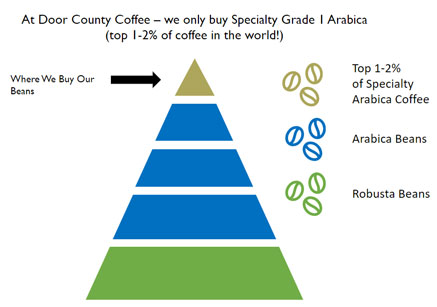COFFEE QUALITY
We use only Specialty Class 1 Arabica coffee beans, the top 2% of what is grown in the world. That means that 98% of what is grown around the world does not meet our standards!
Why we Roast only Class 1 Specialty Arabica Beans?
Arabica Beans are most often considered superior, smoother, and sweeter taste, making them overall the most flavorful coffee beans. Why is that? They are grown at higher altitudes of at least 2,500 feet or higher. The higher the elevation, the denser the beans, giving a fruitier, more floral and more articulate flavor. They also contain lower level of caffeine which contributes to a smoother, more enjoyable cup. These beans are often hand-picked with great care by the farmers who grow and nurture them, making them void of defects and a very consistent and perfect bean.
Robusta coffee beans on the other hand, are grown at lower altitudes, are higher in caffeine content and are more inconsistent in shape and color. All of these leads to less smooth cup of coffee in the end.
Even with Arabica being a superior bean, all Arabica beans are not equal. There are 5 different grades ranging from Class 5 to Class 1. We only use Class 1, Specialty Grade.
You can generally find the type of bean used on the side of the bag of coffee and you will see that we always state 100% Specialty Class 1 Arabica Coffee on each and every package.
Five Grades of Arabica Coffee
- Class 1- Specialty Grade
- Class 2- Premium Grade
- Class 3- Exchange Grade
- Class 4- Below Standard Grade
- Class 5- Off Grade

Where are our beans grown?
We source these beans from many countries including Sumatra, Guatemala, Papa New Guinea, Peru, Bolivia, Costa Rica, Mexico, Colombia, Ethiopia, Java, Kenya, Tanzania, El Salvador, Nicaragua, Panama and Honduras. This list does sometimes change based on the climate changes and other environmental factors that can impact the coffee bean crop in those countries.
Some environmental factors that can impact coffee include rainfall, humidity, sun exposure and soil composition changes.
- Rainfall - Coffee thrives with 60-90 inches of rainfall annually. Below 30 inches per year is stressful to the trees and can cause low yield and small beans inside the cherry. Too much rain, over 120 inches, can lead to mold and fungus
- Temperature - Coffee grows best between 65 and 80 degrees, making the Coffee Belt the perfect location. They also prefer dappled sunlight or direct sunlight in regions further from the equator
- Soil Composition - Ideal soil for coffee is fertile and well-draining, and includes volcanic red earth and deep sandy loam. Too much clay and low pH in the soil can restrict yields. The balance of nutrients in the soil are very important to help the coffee trees produce their best crops year after year.
Each growing region does produce a slighter different bean:
- Central American Coffees – very balanced, mild, clean with a light acidity (what we call brightness)
- South American Coffees – most recognizable classic coffee flavors, mellow acidity with medium body; very well balanced
- African Coffees – Full bodied with mild acidity and fruity, floral notes
- Asian Coffees – Earthy, almost winey and complex taste with heavy notes and good mouthfeel

